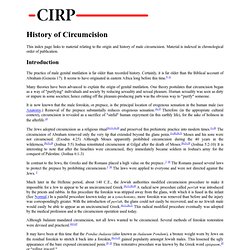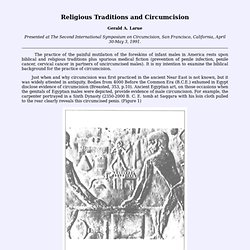

Islam. Jew. Circumcision. History of Circumcision. This index page links to material relating to the origin and history of male circumcision.

Material is indexed in chronological order of publication. The practice of male genital mutilation is far older than recorded history. Certainly, it is far older than the Biblical account of Abraham (Genesis 17). It seems to have originated in eastern Africa long before this time.8 21 Many theories have been advanced to explain the origin of genital mutilation. It is now known that the male foreskin, or prepuce, is the principal location of erogenous sensation in the human male (see Anatomy.) The Jews adopted circumcision as a religious ritual10,13,16,20 and preserved this prehistoric practice into modern times.11,20 The circumcision of Abraham removed only the very tip that extended beyond the glans penis.11,20,26,31 Moses and his sons were not circumcised.
Although Judaism mandated circumcision, not all Jews wanted to be circumcised. Recent History John R. Highlights Frederick M. Origin theories of the rites. Ugandan circumcision ritual in Kibera. Child protection from violence, exploitation and abuse - Female genital mutalitation. Jack Black & Circumcision in Antiquity. Circumcision 'humor' if you will: a movie scene from Year One: While the above video clip is merely Hollywood humor, we would encourage anyone who believes they are circumcising their baby boy for religious reasons to dive into the subject further.

"Cutting the Blessing" among the Hebrews in antiquity was done in a MUCH different fashion than in modern U.S. culture where we amputate the entire prepuce organ. Hebrews and early Jews made a very tiny slit in the tip of the prepuce to allow for mere drops of blood to be shed as the blood sacrifice of the covenant. The Hebrew words used for this practice in the Hebrew Bible (Old Testament) are "namal" and "muwl. " Namal means 'to clip' - like one would clip the tips of your fingernails. At this time in antiquity, we could not possibly amputate the prepuce organ (as circumcision is done today) and expect the child to live!
Side Note: I have been working recently on a compilation of paintings from antiquity representing Jesus as a baby. Biblical Circumcision Information. By Danelle Frisbie © 2010Note: The following was a comment I left for a few colleagues requesting resources for further information on genital cutting in antiquity, and specifically verses from the Bible and circumcision information for use in Christian church classes.

I've been asked several times to make it public for easy access by others, and so I will post it here. This is not intended to be in journal article format. What we now call 'circumcision' was not performed in the same manner in antiquity. At that time it was a 'cutting of the blessing' - a very small slit made at the end of the penis to allow a few drops of blood to fall (or, actually, be sucked out by the mouth of the boy's father or a Rabbi). "Cutting the Blessing" in antiquity was very different than today in modern U.S. culture where we amputate the entire prepuce organ. You could not possibly amputate the prepuce organ in antiquity and expect the child to live. Verses specifically for Christians to consider: Religious Traditions. Gerald A.

Larue Presented at The Second International Symposium on Circumcision, San Francisco, California, April 30-May 3, 1991. The practice of the painful mutilation of the foreskins of infant males in America rests upon biblical and religious traditions plus spurious medical fiction (prevention of penile infection, penile cancer, cervical cancer in partners of uncircumcised males). It is my intention to examine the biblical background for the practice of circumcision. Just when and why circumcision was first practiced in the ancient Near East is not known, but it was widely attested in antiquity.